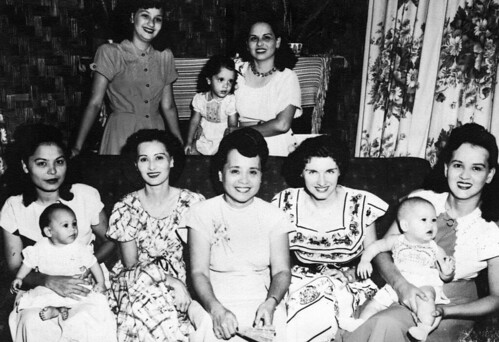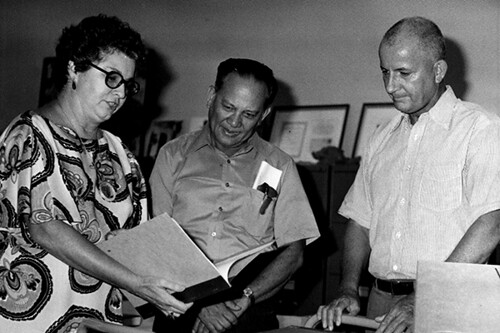Emilie Green Johnston
Archivist and historian
Emilie Green Johnston (1924 – 2011) is a significant figure to historians and researchers of Guam history. Along with Guam historian/professors Paul Carano and Marjorie Driver, Johnston helped found the College of Guam’s (now the University of Guam) first research center. Today, the Richard F. Taitano Micronesian Area Research Center (MARC) is a world-class repository of materials including maps, documents, photographs, and other archived collections about Guam and the islands of Micronesia. In her multiple roles as bibliographer, writer, librarian and curator with MARC, Johnston contributed greatly to making historical knowledge of the region available to the public.
Emilie Johnston was born on 30 March 1924 in Mendenhall, Pennsylvania, to Rowena Bernette Pierce and Joseph Clifton Green, a successful plumber and skeet champion. The oldest of three children, she graduated from Centerville High School in 1941.
Johnston then moved to Baltimore, Maryland, to attend the Maryland Institute of Art. In 1944 at the age of 20 she graduated at the top of her class with a certificate in Costume Design and Clothes Construction. Along with a partner, she opened a dress shop in Baltimore that sold her designs. A year later she moved to New York City where she was a designer and finisher at a French-Italian couturier shop located on Fifth Avenue. It was here that she met the sisters of her future husband.
Chamorro educator Agueda I. Johnston had sent her daughters, Marion and Cynthia, to New York on a trip to the United States. Mrs. Johnston asked family friend Father Hugh F. Costigan, a Jesuit priest, to look after her daughters while they were in New York. Costigan, uncomfortable with looking after the beautiful young ladies, enlisted Emilie Green to entertain them. The girls became close friends. Before departing the sisters asked Emilie if she would look after their brother, Herbert, who would be visiting New York. Emilie agreed and when the two met, they fell madly in love.
Emilie married Herbert J. Johnston on 16 November 1946 in New York. Father Costigan presided over the ceremony; the priest eventually went on to found the Ponape Agriculture and Trade School in the late 1950s and remained a close family friend until his death in 1987.
The young couple moved to Guam in 1947, the same year that Johnston gave birth to her first child, to make their home there. The Johnstons were heartbroken when the infant only lived 23 hours. Around this time Franklin, Herbert’s son, came to live with them and won Johnston’s heart. She adopted him and raised him as her own. Two years later she gave birth to her second child, Rowena. In the ensuing ten years, Johnston bore five more children: Anita, Elizabeth (Libby), Herbert, Jr. (Bert), Melanie and Diana.
Raising seven children in postwar Guam most certainly must have been a challenge to Johnston, but she was tenacious, a trait that served her well throughout her life. Those close to her say she never gave up once she started something.
A founder of RFT-MARC
Although she began her professional life in 1943 as a designer, Johnston’s life’s work began in 1967 when she started collaborating with Carano and Driver to create the Micronesian Area Research Center. The trio spent the early years building the collection of historical material that, today, spans more than 150,000 pages dating from 1521 to the present. Johnston, meanwhile, attended the University of Guam where she received a Bachelor of Arts degree and graduated summa cum laude in 1972.
Johnston started out as a bibliographer/librarian at MARC and was promoted to curator in 1972, a position she held until failing eyesight forced her to retire in 1982.
During her tenure she not only helped build the collection and fulfilled the role of librarian, but she also authored or edited numerous articles, bibliographies and publications that still serve researchers today. She contributed articles to local publications like the Guam Recorder, Micronesica, Umatuna si Yu’us and the Pacific Sunday News Magazine. Much of her work focused on topics in Guam history and culture, such as “Medical Services for the Island Guam Until World War II;” “References to the Latte of the Mariana Islands;” and “Chamorro Tools: Implements and Utensils.” She also supervised the preservation of historical documents regarding water resources and ecological surveys, as well as research materials about the Catholic missionary Father Diego Luis de San Vitores and American era historic sites on Guam.
Johnston also compiled guides for the thousands of photographs at MARC. Indeed, it was Johnston who started the image archives at the research center. She also privately wrote and published A Saga of Agueda about the life and work of her mother-in-law, Agueda I. Johnston, for whom the Ordot-Chalan Pago school is named.
Herbert J. Johnston passed away on 5 May 1993, just six months shy of their 47th anniversary.
After retirement, as tenacious as ever, Emilie Johnston continued to collect and archive historical material despite her failing eyesight. Around this time Jose Babauta became her assistant and caregiver. It was Johnston, Babauta said, that encouraged him to start researching his family’s genealogy.
“She was a remarkable lady,” Babauta recalled. “Even though she couldn’t see, she knew where each document was. She’d say, ‘Go look in the second drawer behind the folder and you’ll find the document.’ When I said I couldn’t find it she would say – ‘Use your eyes’ – and I’d look again and it would be there!” Along with Babauta’s help Johnston continued collecting and archiving different materials, and would entertain researchers and their questions until her last days. She was generous with her time, and after a day-long visit from researchers she would say, “I think they left happy.”
Johnston was active in civic and public organizations at a time when these groups made significant contributions to the welfare of the island’s population. She joined the Guam Women’s Club in 1953 only two years after it was created and remained an active member throughout her life, eventually earning the status of Life Member. Her talent at costume design served her well when preparing for the organization’s annual Mardi Gras gala. For many years her designs won the event’s costume contest.
As a member of the Guam Women’s Club, Johnston also served as co-chair of the Parks, Monuments and Museum Committee. The Guam Women’s Club and the committee were responsible for re-establishing the Guam Museum after World War II as well as the establishment of many of the island’s public parks.
Johnston also served as a board member of the Nieves M. Flores Memorial Library, and participated in various University of Guam activities and Committees. She served as President of the Guam Girl Scout Council and was a member of the Guam Archaeology Society, Guam Fine Arts Society, Chamorro Cultural Association, Guam Teachers Association, Guam Environmental Council, Guam Recreation and Parks Association, Guam Library Association, Pacific Studies Association, American Library Association, National Trust for Historic Preservation and the Guam Sewing Circle.
As a parent she was active in Parent-Teacher Associations of Adelup and Piti Elementary Schools and Hågat Junior High.
Although Johnston passed away on 8 August 2011, her legacy lives on in her children and the thousands of pages of historical documents and images that she collected, archived and published. In 2010, the 30th Guam Legislature awarded her a Legislative Resolution memorializing her contributions and dedication to the Guam community and the preservation of Chamorro culture and history. The University of Guam’s RFT-MARC also honored her that year at an annual dinner event.
For further reading
Guam Legislature. Relative to Memorializing and Acknowledging Emilie G. Johnston… Resolution 300-30. 30th Guam Legislature. 10 March 2010.
I Manfayi: Generations of Public Servants. Vol. 4. The Hale’-ta Series. Hagåtña: Department of Chamorro Affairs, Division of Research, Publication, and Training, 2003.




